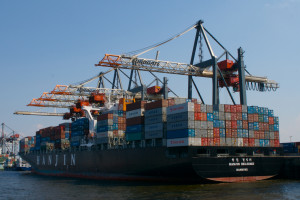You might be feeling concerned about shipping your belongings overseas. What if they don’t properly pack that oddly shaped, antique lamp you inherited from your Aunt Edna when she passed?
You might be surprised to learn that there are actually around seventeen million intermodal containers (also called ISO {International Standards Organization}  Containers, freight containers, shipping containers, conex boxes, high cube containers, and sea cans) in the world that are of varying kinds, and sizes, to suit every different kind of cargo. They come at two standard lengths: 20′ and 40′.
Containers, freight containers, shipping containers, conex boxes, high cube containers, and sea cans) in the world that are of varying kinds, and sizes, to suit every different kind of cargo. They come at two standard lengths: 20′ and 40′.
An Intermodal container is a standardized, multi-use steel box that is intended for the safe, efficient and secure storage and transport of products and materials within a worldwide “containerized intermodal freight transport system”. In other words, “intermodal” means that the container can be transported, and changed, from one mode of transportation to another without having to unpack and repack it, regardless of whether that is by rail, by ship or by truck.
Shipping containers are used to transport anything from home goods, to refrigerated items, to hazardous liquids across the ocean or across land.
The containers come in standard sizes, and in many cases they are stackable so that they fit more cargo into a single space. There are several different types of containers, and each is designed to carry a specific type of goods.
Containers can be divided into two main categories: general cargo and specialized cargo. Within these two categories, there are several subcategories.
General Cargo
Cube Containers
These are what come to mind when most people think of cargo containers – the giant colored boxes that are often seen stacked on ships and whizzing by on trains. These containers are typically made from steel and feature high, sturdy walls and secure lids. They can be used to ship just about any kind of dry, non-perishable cargo, and their square shape and standard sizes (Aggregate container capacity is typically expressed in twenty-foot equivalent units (TEU) which is a unit of capacity equal to one standard 20 ft × 8 ft container) make them easy to stack and move.
Open Cargo Containers
These cargo containers have no lid, which makes them able to accommodate items that are too tall, too bulky, or too oddly-shaped to fit comfortably or easily into cube containers. They are made from corrugated steel, and covered by a canvas for added protection. Beams at the top of the container add stability and support the canvas. The open top makes them particularly easy to pack and unpack.
Flat Racks
These containers lack walls and a lid, so they’re used to ship bulky, unwieldy, or very heavy items, such as logs or machinery.
They generally adhere to standard ISO container sizes. Some flat racks have collapsible ends that can be taken down after a shipment, which saves valuable storage space.
Platform Containers
Platform containers have no ends – they’re just flat slabs of steel. They are, however, very useful for transporting cargo that’s exceptionally heavy, very unusually shaped, or exceptionally bulky.
Specialized Cargo
Reefers
Some items, such as perishable foods, art collections, cut flowers, and archaeological artifacts require shipping in a temperature-controlled environment. Refrigerated cargo containers, or reefers, ensure that no damage, spoiling or aging occurs during the shipping process. Reefers are essential in the shipping world, as they allow for the import and export of delicate produce, meats and cheeses from one country to another.
Some reefer containers stay cold through the use of dry ice or liquid gas. Meanwhile, others contain an electrical refrigeration unit that keeps the whole container at a stable and constant temperature.
Insulated Containers
Insulated containers are also used to ship temperature-sensitive items, such as those that are frozen or refrigerated. They don’t have their own refrigeration unit, but they do have insulated walls that keep items cold during shipment.
Closed Ventilated Containers
Just as some items require a controlled temperature, some others require a specific humidity. Ventilated containers control air flow to preserve the right amount of moisture.
Tank Containers
Liquids can be poured into barrels or drums, then loaded onto dry containers. However, this is not the most efficient, space-saving, or affordable way to ship them. Tank containers are cylindrical containers that are specially designed to hold hazardous and non-hazardous gases and liquids, as well as bulk amounts of powdered or granulated items. They are set into a protective frame that conforms to ISO size standards to make them easier to ship.

